Cultural Digitization in Indonesia Paper
Cultural digitization is a term used to describe the process of converting any kind of audio, visual, or written material into digital format. This process is becoming increasingly popular in Indonesia, as it allows for wider access to the nation's cultural heritage. Additionally, cultural digitization also presents an opportunity to preserve deteriorating materials and protect them from being lost permanently.
The preservation of Indonesia's cultural heritage through digitization is crucial for the recognition and identity of Indonesian people, especially among younger generations and the global community. By digitally preserving Indonesia's cultural heritage, it can be more easily shared and studied by people worldwide. Furthermore, cultural digitization can also propel Indonesia's economic development. As a growing number of people become interested in Indonesian culture, cultural digitization creates new opportunities for industries such as tourism and education. Academicians and heritage practitioners in Indonesia have already begun to embrace the potential benefits of digital media for preservation, communication, and research of cultural heritage.
To further advance cultural digitization in Indonesia, it is essential to establish standardized metadata systems and preservation metadata schemas. Ngulube (2017) emphasizes the importance of conducting a literature review to develop a conceptual definition based on shared meaning and describe theories used to explain the phenomenon of cultural digitization.Cultural digitization in Indonesia has emerged as a critical tool for preserving the nation's rich cultural heritage, promoting its identity and economic growth.
The importance of cultural digitization in Indonesia cannot be overemphasized as it enables wider access to the nation's cultural heritage and also presents an opportunity to preserve deteriorating materials. Moreover, cultural digitization also plays a significant role in promoting Indonesia's identity and economic growth, particularly through tourism and education. Academics and heritage practitioners have already started recognizing the potential benefits of cultural digitization in Indonesia, such as preservation, communication, and research.
Going forward, it is crucial for Indonesia to establish standardized metadata systems and preservation metadata schemas to further advance cultural digitization. Through the use of digital technologies, cultural organizations and institutions can enhance access to Indonesia's rich cultural heritage while preserving deteriorating materials. This not only benefits Indonesians but also enables people worldwide to share and study the nation's cultural heritage. Additionally, Ngulube highlights the importance of conducting a literature review to develop a conceptual definition based on shared meaning and describe theories used to explain cultural digitization.
Consequently, it is necessary to invest in cultural digitization projects that engage the collaboration and participation of various stakeholders. This will require a significant amount of resources that can be allocated by cultural institutions or the government in the upcoming period to successfully achieve digitization, preservation and valorization of cultural heritage in Indonesia. By investing in cultural digitization projects that engage various stakeholders, Indonesia can ensure the successful digitization, preservation and valorization of its rich cultural heritage.
Furthermore, the development of digital-based learning in Indonesia highlights the country's commitment to improving its education system by improvising and advancing it through innovative teaching techniques that meet the current needs of the digital age. It is crucial for Indonesia to continue promoting the development and utilization of digital-based learning media. In light of Indonesia's commitment to preserving and promoting its cultural heritage, as well as advancing its education system through digital innovation, it is imperative for the government and other relevant stakeholders to continue to invest in digital technologies that can benefit the citizens of Indonesia.
This investment will promote social and economic growth, as Indonesia continues to transition into a digital era. To effectively preserve and advance cultural digitization, it is crucial to establish standardized metadata systems and preservation metadata schemas. Standardized metadata systems and preservation metadata schemas will enable efficient organization, retrieval, and long-term preservation of digital cultural heritage. Metadata play a vital role in the long-term preservation of digital objects, and it is essential to identify the correct metadata that may help retrieve specific objects from the archive after preservation.
In addition, cultural digitization also has significant implications for theories of globalization and cultural change.The increasing globalization of the world demands a shift in attitudes towards cultural preservation and representation. Through proper digitization and preservation of cultural heritage, countries like Indonesia can improve their representation on a global scale while also promoting cross-cultural understanding and appreciation.
Reference:
Sari, E. A. (2020). Cultural Digitization in Indonesia: A Literature Review. Jurnal Ilmu Budaya, 4(1), 39-52. This article provides an overview of the current state of cultural digitization in Indonesia, discussing the challenges and opportunities faced by cultural institutions in the country.
Prabowo, H. A., & Setiawan, M. A. (2020). Digital Heritage Preservation in Indonesia: Challenges and Opportunities. Journal of Digital Information Management, 18(6), 289-296. This article focuses on the preservation of Indonesia's digital heritage, highlighting the importance of developing strategies to protect the country's rich cultural heritage in the digital age.
Rahmat, I. (2021). Mapping the Digital Culture Ecosystem in Indonesia. Journal of Cultural Heritage Management and Sustainable Development, 11(1), 14-28. This paper examines the digital culture ecosystem in Indonesia, exploring the ways in which cultural institutions, government agencies, and other stakeholders are working to promote cultural digitization and preserve Indonesia's cultural heritage for future generations.
Diskusi
Silahkan masuk untuk berdiskusi.Daftar Diskusi
Rekomendasi Entri
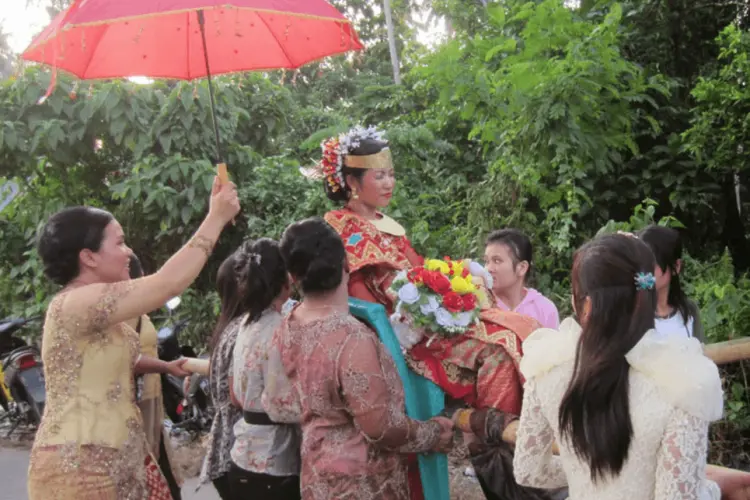
Upacara Kelahiran di Nias
Kelahiran seorang anak yang dinantikan tentu membuat seorang ibu serta keluarga menjadi bahagia karena dapat bertemu dengan buah hatinya, terutama bagi ibu (melahirkan anak pertama). Tetapi tidak sedikit pula ibu yang mengalami stress yang bersamaan dengan rasa bahagia itu. Tujuan penelitian ini adalah untuk mendeskripsikan tentang makna dari pra-kelahiran seseorang dalam adat Nias khusunya di Nias Barat, Kecamatan Lahomi Desa Tigaserangkai, dan menjelaskan tentang proses kelahiran anak mulai dari memberikan nama famanoro ono khora sibaya. Metode pelaksanaan dalam penelitian ini adalah menggunakan metode observasi dan metode wawancara dengan pendekatan deskriptif. pendekatan deskriptif digunakan untuk mendeskripsikan fakta sosial dan memberikan keterangan yang jelas mengenai Pra-Kelahiran dalam adat Nias. Adapun hasil dalam pembahasan ini adalah pra-kelahiran, pada waktu melahirkan anak, Pemberian Nama (Famatorõ Tõi), acara famangõrõ ono khõ zibaya (Mengantar anak ke rumah paman)...

Admin Budaya
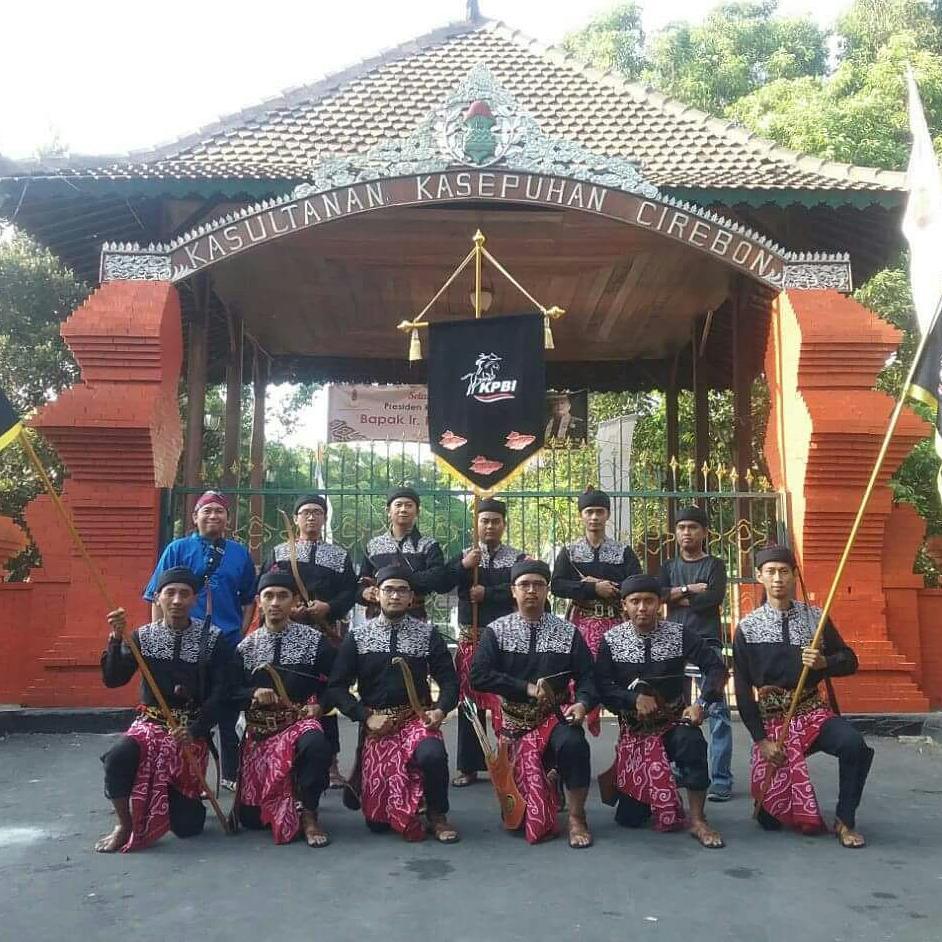
Prajurit Pemanah Kasultanan Kasepuhan Cirebon Di Festival Keraton Nusantara
Prajurit pemanah dari komunitas pemanah berkuda indonesia (KPBI) mengikuti Festival Keraton Nusantara 2017. mewakili kesultanan kasepuhan cirebon. PAKAIAN: terdiri dari ikat kepala/ totopong khas sunda jenis mahkuta wangsa. kain sembongb berwarnaungu di ikat di pinggang bersamaan dengan senjata tajam seperti golok dan pisau lalu baju & celana pangsi sunda. dengan baju corak ukiran batik khas sunda di bagian dada. untuk alas kaki sebagian besar memakai sendal gunung, namun juga ada yang memakai sepatu berkuda. BUSUR: sebagian besar memakai busur dengan model bentuk turkis dan ada juga memakai busur model bentuk korea. ANAK PANAH: Semua nya memakai anak panah bahan natural seperti bambu tonkin, kayu mapple & kayu spruce QUIVER (TEMPAT ANAK PANAH): Semua pemanah menggunakan quiver jenis backside quiver atau hip quiver . yaitu quiver yang anak panah di pasang di pinggang dan apabila anak panah di pasang di dalam quiver , nock anak panah menghadap ke belaka...

ASEP NU KASEP TEA ATUH PIRAKU
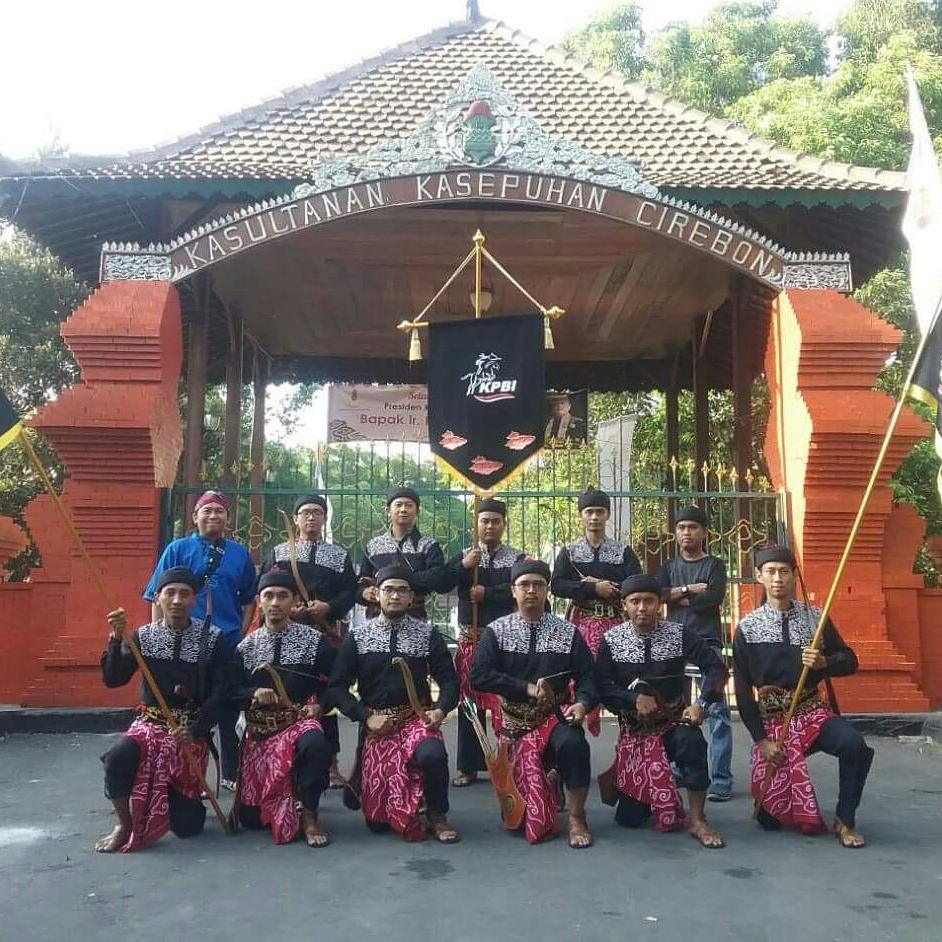
Prajurit pemanah kasultanan kasepuhan cirebon di festival keraton nusantara
Prajurit pemanah dari komunitas pemanah berkuda indonesia (KPBI) mengikuti Festival Keraton Nusantara 2017. mewakili kesultanan kasepuhan cirebon. PAKAIAN : terdiri dari ikat kepala/ totopong khas sunda jenis mahkuta wangsa. kain sembong berwarna ungu di ikat di pinggang bersamaan dengan senjata tajam seperti golok ataupun pisau lalu baju & celana pangsi sunda. dengan baju corak ukiran batik khas sunda di bagian dada. untuk alas kaki sebagian besar memakai sendal gunung, namun juga ada yang memakai sepatu berkuda. BUSUR : sebagian besar memakai busur dengan model bentuk turkis dan ada juga memakai busur model bentuk korea. ANAK PANAH : Semua nya memakai anak panah bahan natural seperti bambu tonkin, kayu mapple & kayu spruce QUIVER (TEMPAT ANAK PANAH): Semua pemanah menggunakan quiver jenis backside quiver atau hip quiver . yaitu quiver yang anak panah di pasang di pinggang dan apabila anak panah di pasang di dalam quiver , nock anak panah menghad...

ASEP NU KASEP TEA ATUH PIRAKU
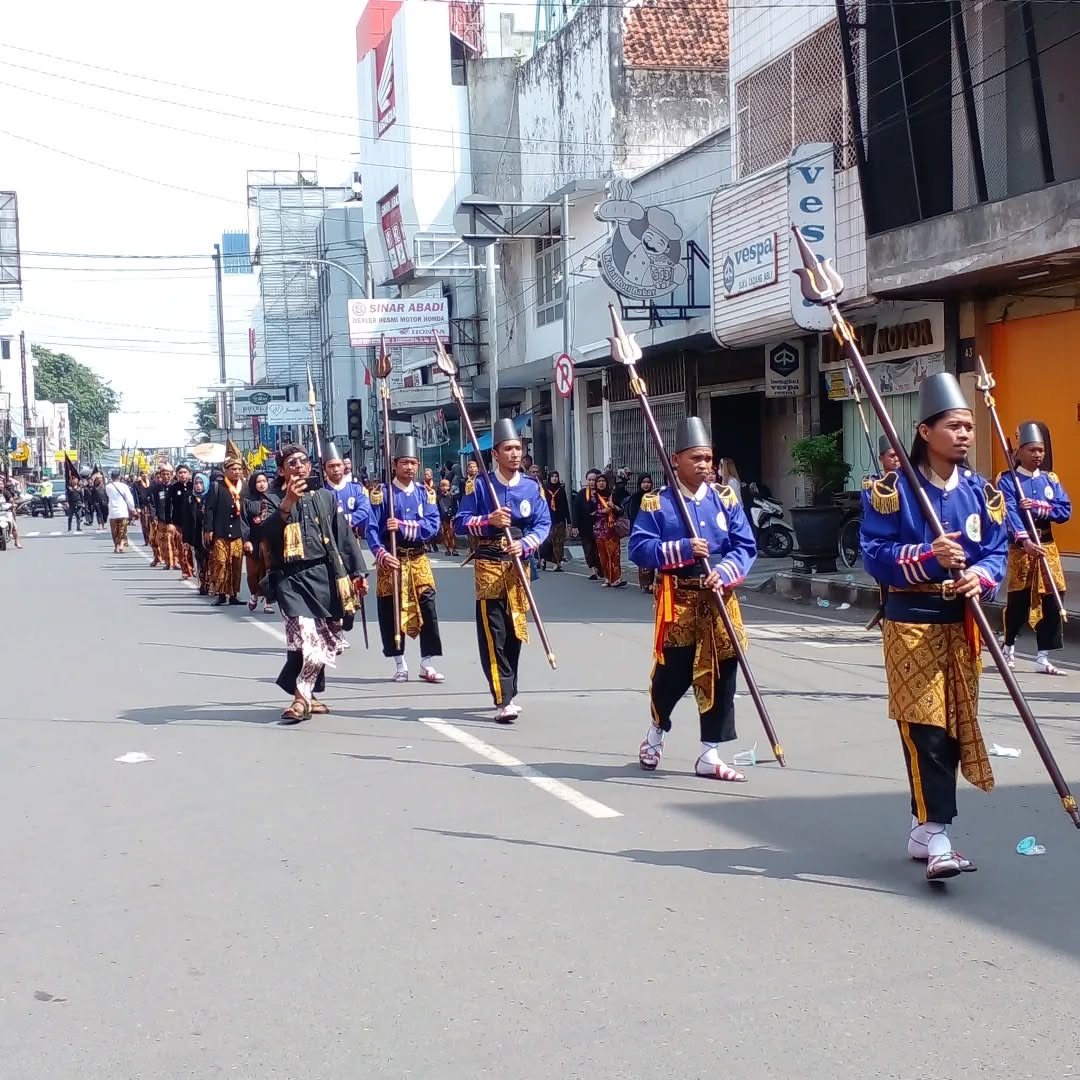
Kirab agung milad ke 215 kesultanan kacirebonan
aksi pertunjukan pusaka dan pasukan kesultanan kacirebonan dari balaikota cirebon sampai ke keraton kacirebonan

ASEP NU KASEP TEA ATUH PIRAKU
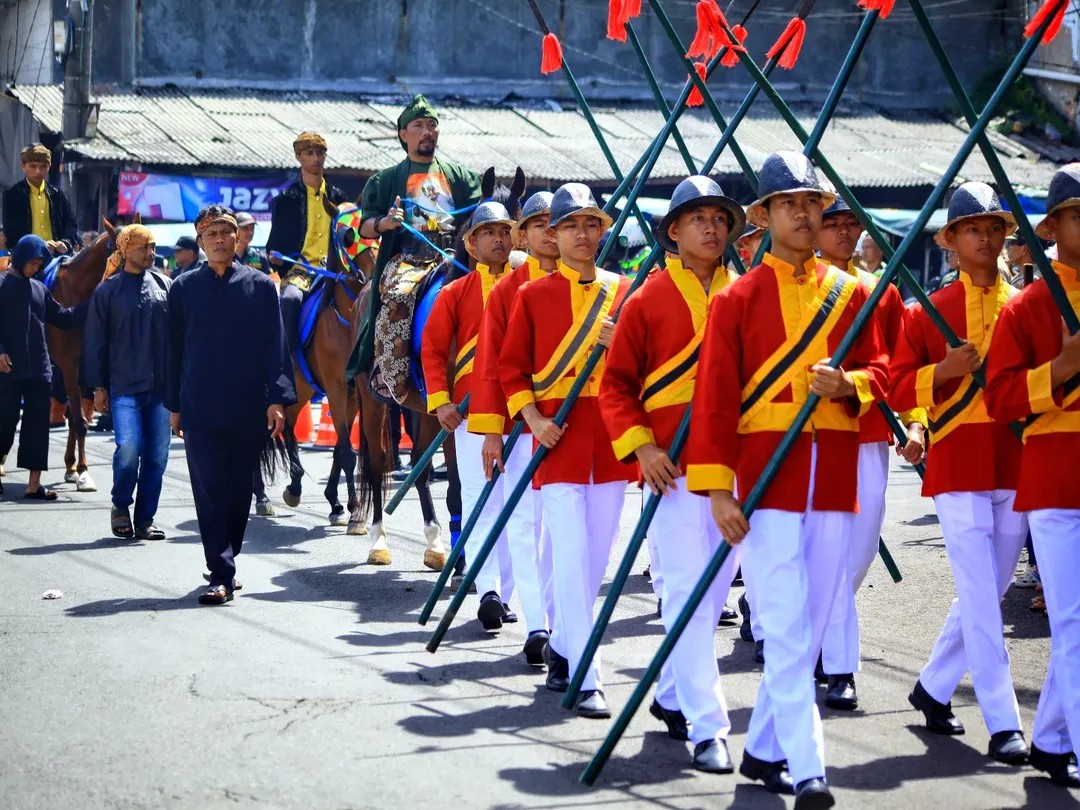
PANURUNG: Pasukan Pengawal Keraton Sumedang Larang
Para pasukan penjaga keraton Sumedang larang
